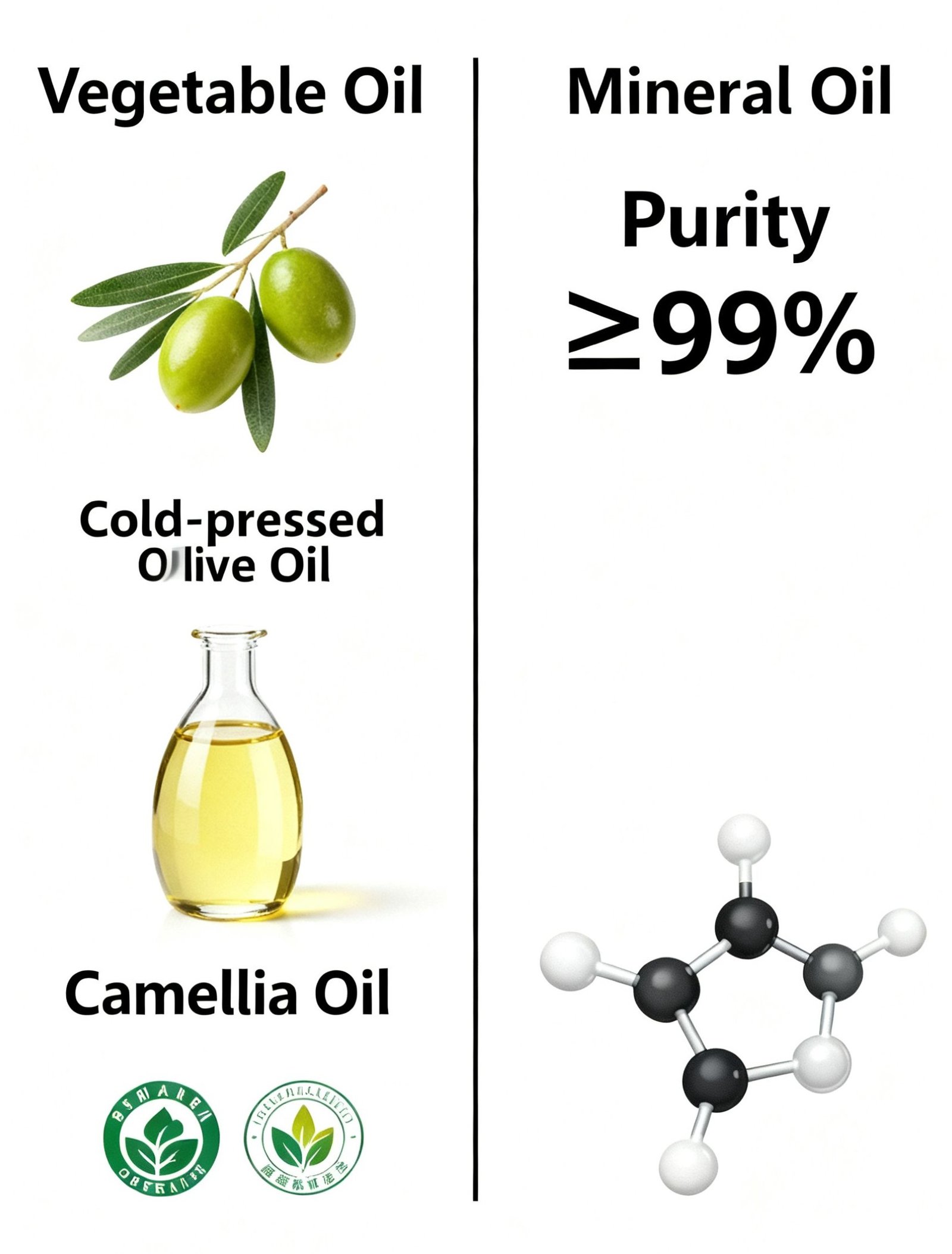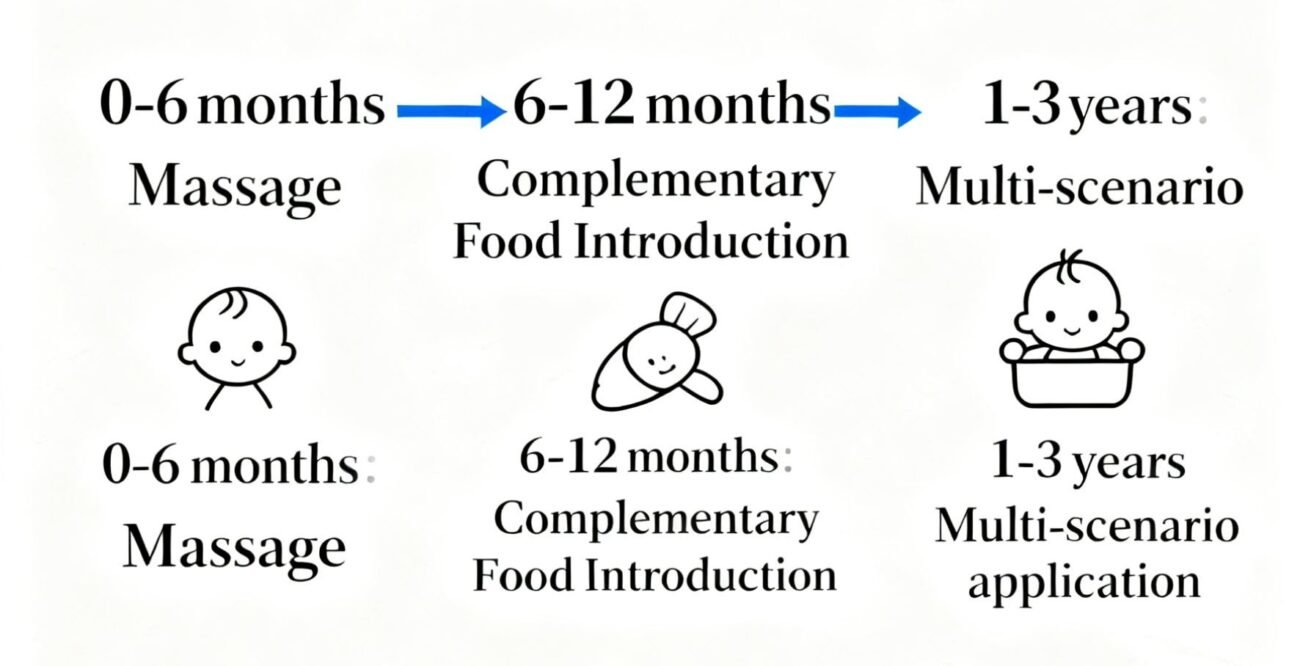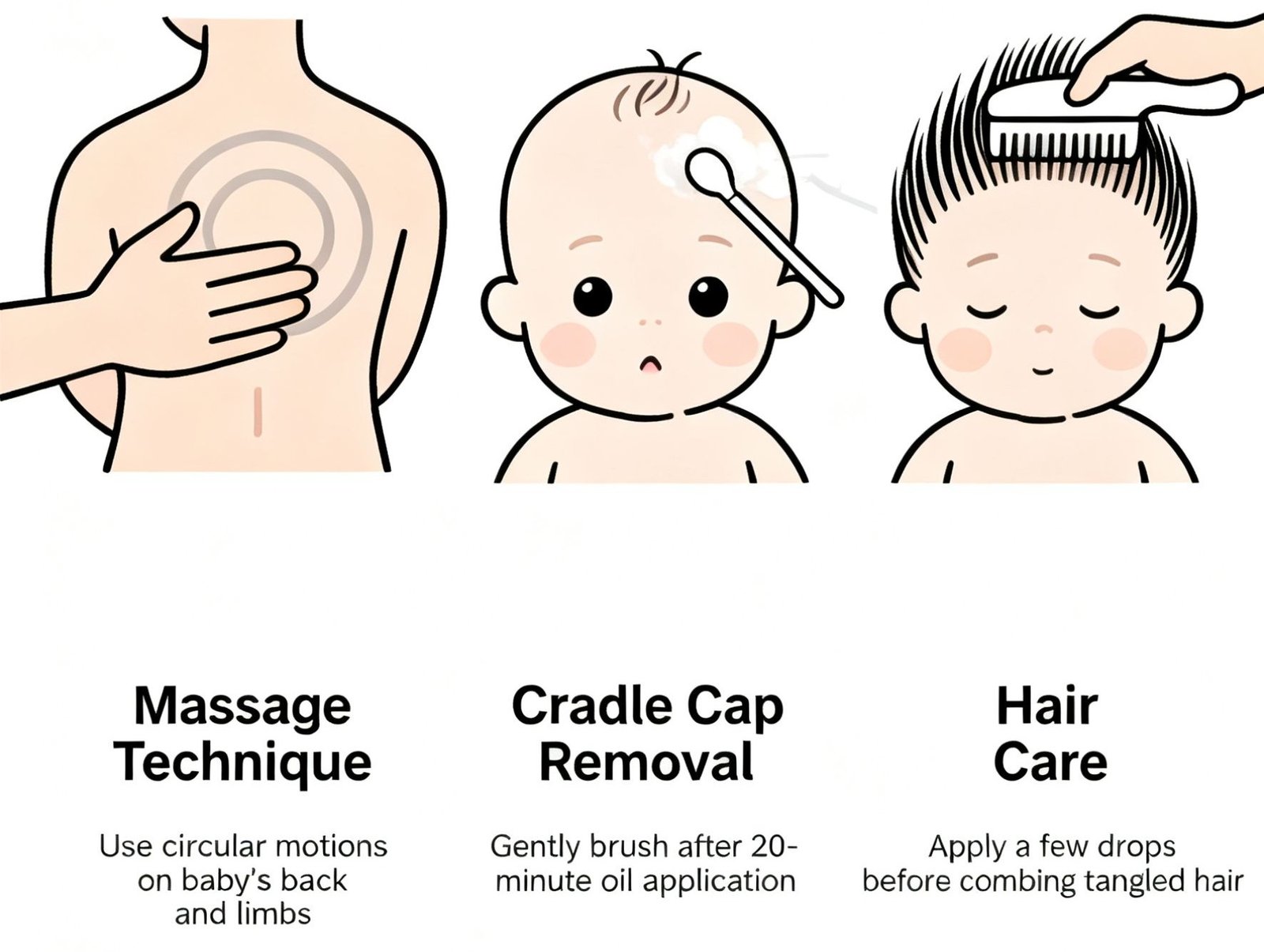As a core product for skin care of babies aged 0-3, baby oil serves not only as a basic medium for touch and massage, but also as a nutritional supplement during the complementary food addition period, and can even solve various care problems in daily parenting. Based on international cosmetics regulatory standards (including certification requirements of FDA/EC/ECHA/MHRA/PMDA), this article provides a scientific and practical full-scenario usage guide covering ingredient safety, age-specific plans and cross-border purchasing.
I. How to Choose Baby Oil Suitable for Your Baby?
1. Three Principles for Ingredient Selection
- Prioritize vegetable oils: Cold-pressed olive oil (contains oleic acid), camellia oil (contains squalene), and walnut oil (contains alpha-linolenic acid) are ideal choices. Avoid mineral oils and synthetic oils.
- Additive-free formula: Ensure the product contains no fragrances, alcohol, or pigments. Prioritize products labeled “fragrance-free”.
- Certification marks: Look for EU ECOCERT Organic certification or USDA Organic certification. The content of organic ingredients must be ≥ 95%.
2. Recommendations on Packaging and Specifications
- Pump dispenser design: Enables precise dosage control and prevents contamination.
- Small-capacity packaging: Should be used up within 3 months after opening; it is recommended to choose specifications of 100ml or less.
- Dark glass bottle: Prevents vegetable oils from oxidizing and deteriorating (suitable for high-end organic brands).

II. Age-Appropriate Usage Plan (All Stages for 0-3 Years Old)
1.Neonatal Period (0-6 Months)
- Usage Scenarios: Tactile massage, cradle cap cleaning
- Dosage Standard: 3-5ml each time (approximately the amount that fits in an adult’s palm)
- Operation Key Points:
- Preheat the oil to body temperature before massage.
- Avoid the eyes, mouth, nose, and unhealed umbilical wounds.
- Massage the abdomen using the “C-shaped” technique.

2. Complementary Food Introduction Period (6-12 Months)
- Usage Guidelines:
- For the first introduction, start with 1 drop and mix it into rice cereal or fruit puree.
- The maximum daily dosage should not exceed 10g (approximately 1 tablespoon).
- Recommended options: Walnut Oil (contains DHA) and Flaxseed Oil (contains ALA).
- Enhanced External Use:
- It can be used for diaper rash prevention. Apply a thin layer to form a protective film before changing diapers.
3. Toddler Stage (1-3 Years Old)
- Increased Dosage:
- 15-20g per day for oral consumption
- 8-10ml per use for external application
- New Usage Development:
- As a natural hair conditioner (apply before combing tangled hair)
- To soften nasal secretions (use with a nasal aspirator)
- To remove stubborn stains from babies’ hands (e.g., crayon, paint)

III. 9 Useful Tips You Didn’t Know About
1. Caring for Special Areas
- Cradle Cap Treatment: Apply and leave on for 20 minutes, then gently brush with a soft-bristled brush.
- Earwax Cleaning: Dip a cotton swab in the oil and rotate it along the outer ear canal (do not insert more than 0.5cm deep).
- Navel Care: After each bath, dip a cotton swab in the oil to clean the folds around the navel.
2. Solving Common Parenting Problems
- Relieving Stuffy Nose: Put 1 drop into each nostril, and clean with a nasal aspirator after 10 minutes.
- Preventing Diaper Rash: Apply before changing diapers to form a waterproof protective layer.
- Removing Sticker Residue: Soak the residue with the oil, let it sit for 1 minute, then peel it off easily.
3. Useful Tips for Moms Too
- Makeup Removal: Gently removes waterproof makeup.
- Hair Care: Apply to the ends of hair before blow-drying to prevent split ends.
- Leather Care: Wipe the leather parts of the baby’s high chair.

IV. Pitfall-Avoidance Guide
1. Misconceptions
- ❌ “Mineral oil is absorbed by the skin and causes poisoning”
- ✅ Medical-grade mineral oil has a large molecular weight, will not be absorbed, and is highly safe.
- ❌ “Oils clog pores and cause acne”
- ✅ High-quality baby oil contains penetration-enhancing ingredients, which instead help the skin breathe.
2. Usage Mistakes
- Excessive use (Correct method: 2-3 times a week in summer, daily use is acceptable in winter)
- Pouring directly onto the baby’s skin (Correct: First pour onto the palms and rub evenly)
- Long-term storage after opening (Correct: Use up within 3 months and store away from light)
V. Safe Usage FAQ
How to perform an allergy test?
Apply a small amount to the inside of the baby’s forearm. If there is no redness or rash within 24 hours, it can be used with confidence. It is recommended to choose Friday for the first use to facilitate observation of the baby’s reaction over the weekend.
Does baby oil need to be removed/made up?
Regular baby oil can be easily washed off with warm water; for waterproof formulas, it is recommended to use a baby-specific body wash, or first wipe with a damp towel before rinsing.
How long can it be stored after opening?
Vegetable Oils: Within 3 months after opening (refrigeration required)
Mineral Oils: Within 6 months after opening (storage at room temperature)
Mixed Formulas: Within 4 months after opening (storage in a cool place)
Can premature babies use it?
For premature infants with a gestational age of less than 37 weeks, it is recommended to choose a specialized premature infant formula and use it under the guidance of a doctor.
VI. Emergency Response Guide
1.Accidental Eye Contact
Immediately rinse with physiological saline; there is no need to use eye wash. In most cases, discomfort will subside within 10 minutes.
2.Allergic Reactions
- Mild (local redness and swelling): Discontinue use and apply calamine lotion.
- Moderate (rash): Take cetirizine drops orally (dosage calculated based on body weight).
- Severe (difficulty breathing): Seek medical attention immediately and bring the product packaging.
3. Handling Accidental Ingestion
- For a small amount of accidental ingestion: No special treatment is needed; just drink more water.
- For a large amount of accidental ingestion (more than 30ml): Observe for 4 hours. Seek medical attention if vomiting occurs.
Proper use of baby oil not only solves daily care problems but also provides natural protection for babies. Remember: when choosing, “the simpler the ingredients, the better”; when using, “it’s better to use less than more”; when storing, “pay attention to the shelf life”. It is recommended that each family prepare two types of baby oil: a regular one for daily care and an organic one for special needs, to cope with different scenarios.


